Museum Loan Kits
Our kits are getting updated!
Loan kits are designed to create active learning opportunities for students, specifically in the realm of local history. They include informational packets, activity guidelines, and relevant artifacts from the Museum’s Education Collection. Each kit is geared towards a specific age group, listed below in the kit descriptions.
Since 2022, we’ve been updating our loan kits to more closely follow current history education practices. These kits will especially focus on students’ critical thinking and analysis through an inquiry packet and source materials. Updated kits will have fewer large artifacts to make them easier to transport, though more can be included upon request. If a kit has been updated, it will be noted below in the kit descriptions.
We also want our resources to be more accessible, so we’ve decided to offer online versions of the updated kits. These online kits will include the same inquiry packets and source materials as the physical kits, but will not offer access to artifacts. Because this is an ongoing process, not all kits will be available online at all times.
Contact Director of Youth & Family Education Emily McCusker for more information.
How to Use a Loan Kit:
Request a physical loan kit. You are responsible for picking up and dropping off loan kits at the McLean County Museum of History. Kits can be reserved for two weeks, though more time can be requested if multiple educators from the same institution plan on using the resources.
Request an online loan kit. When your request is received, you will get a link to a google folder that contains the inquiry packet and source materials of the kit you have chosen.
Please make reservations at least (2) weeks in advance. Keep in mind that we only have one or two of each kit. The earlier you make your request, the less likely it is that the kits will already be checked out.
This program is made possible through the Estate of Laura Sullivan.
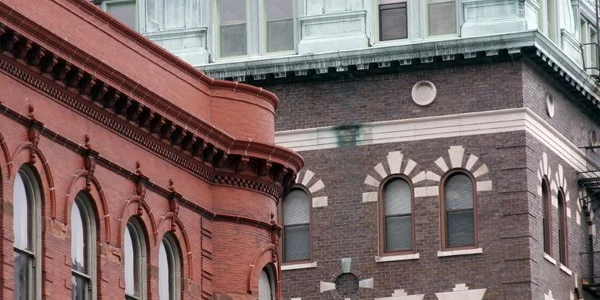
Architecture of Downtown Bloomington
- 3rd to 6th Grade
Through the objects, activities, and resources in this kit, students will become familiar with various facets of urban architecture, using Downtown Bloomington as a case study. They will be introduced to important McLean County architects, recognition of architectural design elements, and the themes of preservation and renewal. (Recommended to elementary-middle school students).
Some (but not all) of the standards met by this kit include:
SS.3.G.2 Explain how culture influences the way people modify and adapt to the environment or the way people do not modify and adapt to their environments.
SS.4.G.2 Explain how the cultural and environmental characteristics of places change over time.
SS.4.G.3 Investigate the human effects on the physical environment over time.
SS.5.G.2 Investigate and explain how the cultural and environmental characteristics of places within the United States change over time.
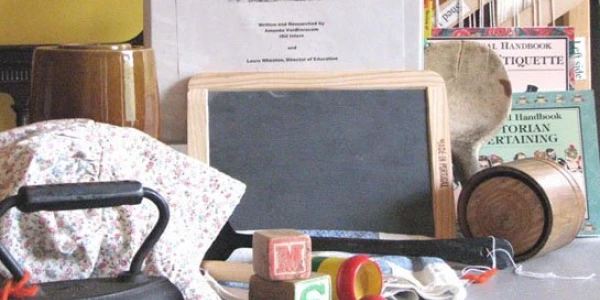
Finding McLean County: Early Settler Life
- Pre-K to 2nd Grade
Through the objects and activities in this kit, students will discover what life was like when the first white settlers came to what is now McLean County almost 200 years ago. By engaging with period artifacts like clothing, kitchen tools, toys, and more, students will investigate the economic, social, and technological changes of the mid-1800s. (Recommended for pre-k and elementary students).
Some (but not all) of the standards met by this kit include:
SS.K.H.1. With guidance and support, compare life in the past to life today, including the points of view of diverse groups of people.
SS.1.EC.2 Describe the skills and knowledge required to produce certain goods and services.
SS.2.G.3 Describe the connections between the physical environment of a place and the economic activities found there.
SS.2.H.1 Identify main ideas and changes that have occurred in the local community over time and retell how these changes impacted diverse groups in the community.
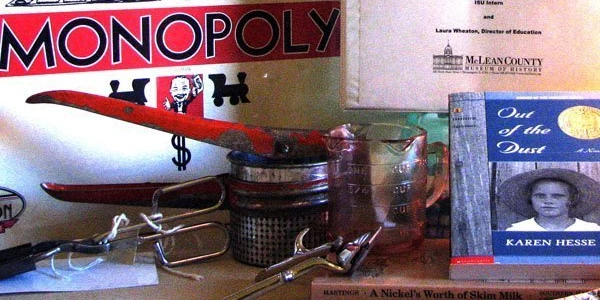
The Great Depression in McLean County
- 6th to 12th Grade
Through the objects, activities, primary sources, and inquiry-based lessons in this kit, students will investigate how the Great Depression affected the United States and, more specifically, the residents of McLean County. Students will be introduced to true stories of local individuals, photos of recognizable McLean County locations, and an opportunity to connect to the history of Central Illinois. (Recommended for middle-high school students).
Some (but not all) of the standards met by this kit include:
SS.H.5.9-12. Analyze the factors and historical context that influenced
the perspectives of people during different historical eras.
SS.H.8.9-12. Analyze key historical events and contributions of
individuals through a variety of perspectives, including those of
historically underrepresented groups.
SS.IS.1.9-12. Address essential questions that reflect an enduring issue
in the field.
SS.IS.5.9-12. Identify evidence that draws information from multiple
sources to revise or strengthen claims.
This kit was updated in 2024 and is available online.
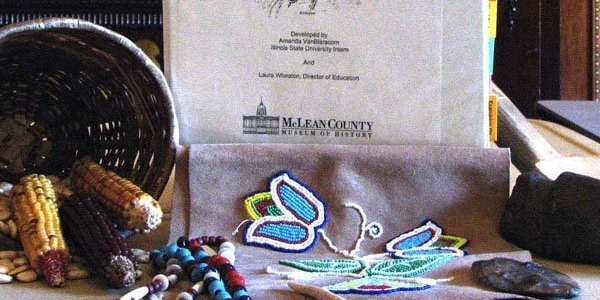
The Unconquerable: Kickapoo in McLean County
- Pre-K to 2nd Grade
Through the objects and activities in this kit, students will be introduced to the lifeways and traditions of the Kickapoo- the last Native Tribe to reside in what is now McLean County. The kit includes stone tools, clothing, information on the Kickapoo, and more. (Recommended for pre-k and elementary students).
Some (but not all) of the standards met by this kit include:
SS.1.G.3. Compare how people in different types of communities use local and worldwide environments to meet their daily needs.
SS.3.G.2. Explain how culture influences the way people modify and adapt to the environment or the way people do not modify and adapt to their environments.
SS.6-8.G.2.L.C. Explain how humans and their environment affect one another.
SS.K.H.1. With guidance and support, compare life in the past to life today, including the points of view of diverse groups of people.
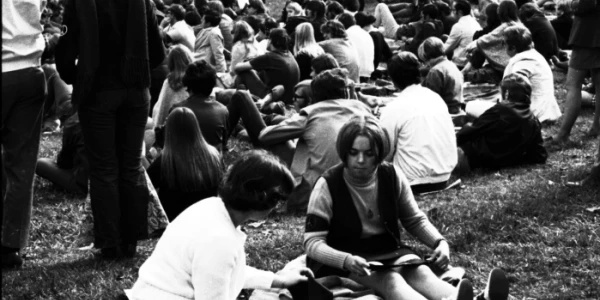
The Vietnam War in McLean County
- 6th to 12th Grade
Through the objects, activities, primary sources, and inquiry-based lessons in this kit, students will learn about the community reaction(s) to the Vietnam War in McLean County. They will discuss the draft, local anti-war protests, and the experiences of soldiers who fought in Vietnam. (Recommended for middle-high school students).
Some (but not all) of the standards met by this kit include:
SS.H.5.9-12. Analyze the factors and historical context that influenced
the perspectives of people during different historical eras.
SS.H.10.9-12. Analyze the causes and effects of global conflicts and
economic crises.
SS.IS.5.9-12. Identify evidence that draws information from multiple
sources to revise or strengthen claims.
SS.IS.8.9-12. Use interdisciplinary lenses to analyze the causes and
effects of and identify solutions to local, regional, or global concerns.
This kit was created in 2024 and is still under construction. It is currently only available online.
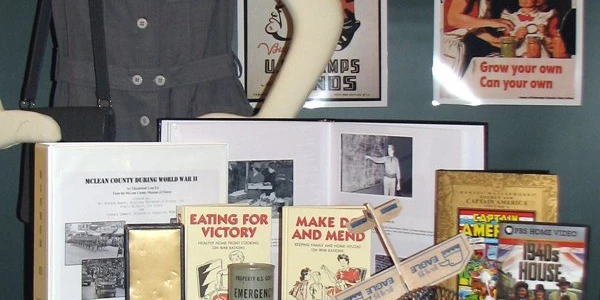
World War II in McLean County
- 6th to 12th Grade
Through the objects, activities, primary sources, and inquiry-based lessons in this kit, students will learn about the diverse homefront experiences of McLean County residents based on their demographics. They will also be exposed to the stories and artifacts of World War II soldiers. (Recommended for middle-high school students).
Some (but not all) of the standards met by this kit include:
SS.H.7.9-12. Identify the role of individuals, groups, and institutions in
people’s struggle for safety, freedom, equality, and justice.
SS.H.8.9-12. Analyze key historical events and contributions of
individuals through a variety of perspectives, including those of
historically underrepresented groups.
SS.IS.4.9-12. Gather and evaluate information from multiple sources
while considering the origin, credibility, point of view, authority,
structure, context, and corroborative value of the sources.
SS.IS.8.9-12. Use interdisciplinary lenses to analyze the causes and
effects of and identify solutions to local, regional, or global concerns.
This kit was updated in 2023 and is available online.